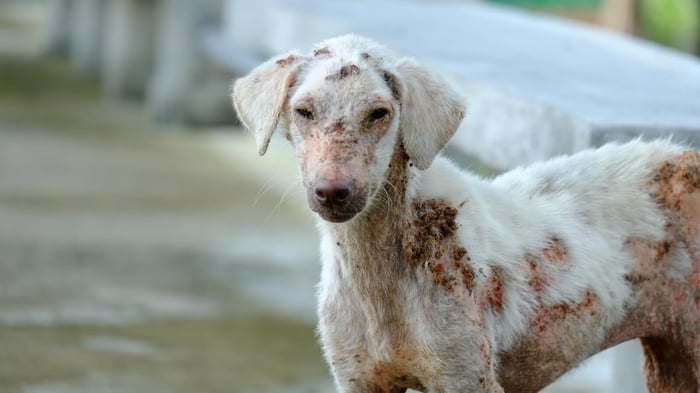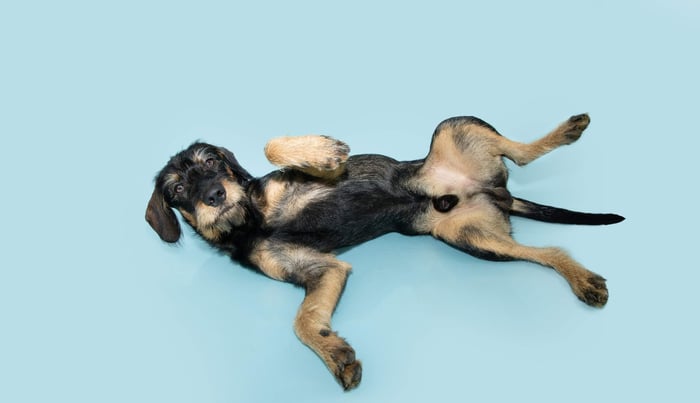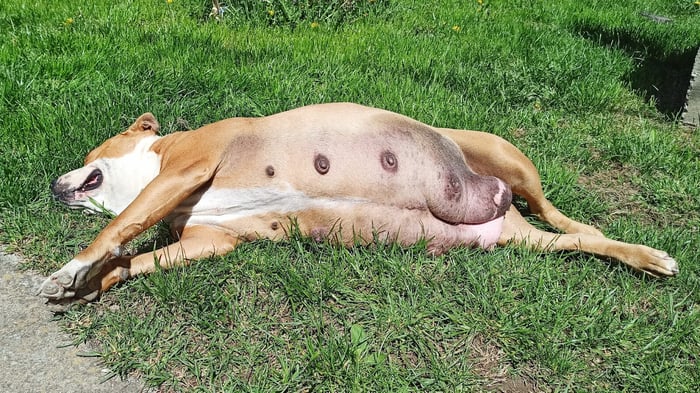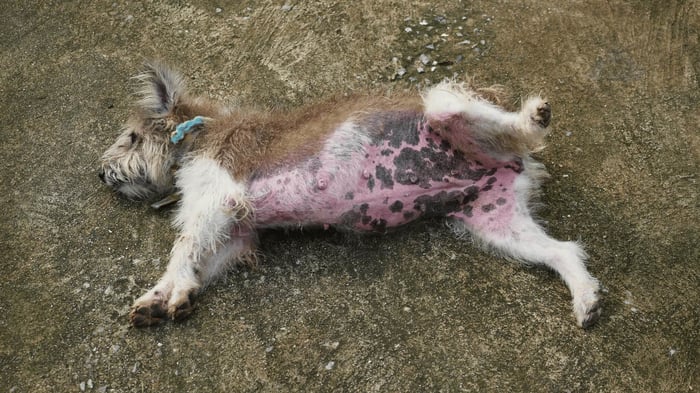When you see a dog losing hair in patches and scabs on the skin, you have a right to be alarmed. Skin disorders like this are often itchy, painful, and just generally uncomfortable for your dog. They can also cause nasty secondary infections.
Whenever you deal with skin issues that cause hair loss and scabs, it’s vital to use gentle dog shampoos that reduce inflammation and help with itching. But it’s just as essential to get to the bottom of what is happening to your dog’s health, as this kind of skin problem can be tricky and challenging to treat.
To get to the root of the problem, we’ve consulted the work of Dr. Irke et al. in Skin Diseases of the Dog and Cat. So let’s dive in.
So, why is a dog losing hair in patches with scabs?
Dogs lose patches of hair and form scabs on their skin because of parasites like mites that give mange, bacterial or fungal skin infections (pyoderma), allergies, self-harming behavior, contact with chemicals or substances that burn or irritate the skin, nutritional deficiencies, immune or hormonal disorders.
Patchy hair loss in dogs can happen for many reasons, including stress or seasonal alopecia. However, hair loss with scabs means that the top layer of the skin is damaged, infected, or inflamed. So this article will focus on conditions that cause hair to fall out in dogs and damage the skin.
Skin problems are also genetic, with studies showing that purebred dogs have far more genetic skin disorders than mixed breeds. Because of this, most of us with purebred dogs will probably have to deal with hair loss and skin rashes with sores, scabs, and even pus at times.
Some skin issues that cause sores, ulcers, scabs, and hair loss are specific to certain dog breeds. For example:
- West Highland Terriers and Hyperplastic Dermatosis;
- German Shepherd Pyoderma; and
- Dermatomyositis in Collies & Shetland Sheepdogs.
But first, we need to address some key terms we need to understand when dealing with skin disorders.
Important Terms to Understand Dog Skin Problem
We need to understand some key terms when dealing with dog skin issues. Briefly:
- Dermatitis: This is absolutely any inflammation in the skin. If your dog’s skin is red, irritated, and inflamed, they have dermatitis. Dermatitis can be caused by anything from allergies to burns or infections.
- Alopecia: This means hair loss.
- Pruritus: This is when the skin is itchy. Not all skin conditions are itchy, so it’s important to notice when your dog is scratching, and the skin is pruritic (itchy). This is an important clue to what the problem is.
- Epidermis: This is the upper layer of skin. When the epidermis is inflamed or infected, you will see crusting and scaling (scabs).
- Dermis: Below the epidermis is the dermis, a deeper layer of skin. When this is affected, pus, discharge, and skin start to fall off (sloughing).
Now that we’ve covered some technical terms. Let’s dive into individual reasons and treatments for alopecia (hair loss) and lesions that cause crusting or scabs.
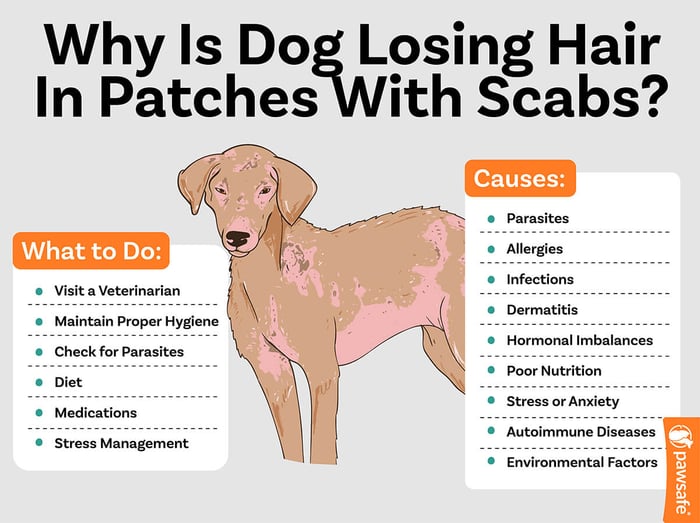
6 Reasons for a Dog Losing Hair in Patches with Scabs
1. Bacterial and Fungal Infections
When dealing with scabs, we look at damage to the upper layer of skin (epidermis). This usually means pyoderma, a term for bacterial skin infections. Our article on black scabs in dogs discusses some of the different kinds of pyoderma.
Dogs have a higher skin PH, so it’s easier for bacteria to multiply in their skin. But this is usually only a problem when something breaks the skin barrier. This could happen from:
- An injury;
- Damage to the calluses or pressure points on big dogs (such as on their elbows);
- Parasite bites;
- Underlying health issues; or
- From a dog chewing or scratching themselves, such as when they have an allergy.
This means that pyoderma is often a secondary infection to other skin problems in dogs that cause hair loss and sores. Nevertheless, once a dog has pyoderma, it can be tricky to treat.
Briefly, some of the infections that can cause hair loss and scabs include:
- Folliculitis or staph infections: Small circles of hair fall out around a crust or scab as hair follicles become infected. This is common in short-haired dogs and can start with keratin building up in the pores (blackheads).
- German Shepherd pyoderma: This is usually severe sores and bald patches, especially around a dog’s groin, mouth, ear, and eyes.
- Pyotraumatic dermatitis usually in puppies.
- Superficial spreading pyoderma: common with folliculitis.
- Acral lick dermatitis: a sore (usually on the leg or paw) that starts because a dog keeps licking one spot.
- Callus or pressure point pyoderma: This affects the area on a big dog that has lost hair and become a callus, most often on hocks and elbows.
- Hotspots or Pyotraumatic dermatitis: These are stinky moist spots that lose hair usually where the skin is damaged. Dark scabs will form in the bald spot when it heals.
- Skin fold dermatitis: This usually happens in dogs with severe wrinkles. The moist environment and friction in the skin folds cause bacteria or fungi to thrive and infect the skin. This can rub away the hair and make sores and scabs.
You can also have patchy hair loss and scabs in particular areas, such as the edges of dog ears.
Fungal infections like ringworm also cause round bald patches that can look dry and scaly in the middle. Yeast infections, particularly yeast dermatitis or Malassezia dermatitis, is another major cause of crusty, flaky, and scaly skin that can cause patches of hair loss.
Treatment
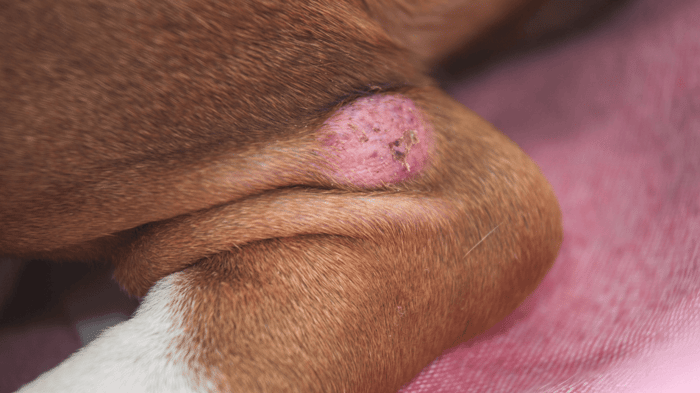
Treating fungal and bacterial skin infections is tricky, as they are often drug resistant. OTC medications are often not effective, and it’s best to see your vet for antibiotic, antifungal, or steroidal medicines.
2. Nutritional Deficiencies
Specific nutritional deficiencies can cause a dog’s hair to fall out and crusts or sores to form. When hair loss, red skin, and scabs form around the eyes, you are probably looking at a zinc deficiency. Type 1 zinc deficiencies are common in Northern breeds like Huskies that sometimes can’t absorb zinc well.
Type 2 zinc deficiencies can happen in large-breed dogs, particularly ones that are growing. You will need to speak to your vet about an appropriate zinc supplement.
Other nutrients that can cause hair loss and scabs on the skin include:
- Omega-3 fatty acid deficiencies: dry, flaky, itchy skin with brittle hair. Scratching can cause bald patches, sores, and scabs.
- Vitamin A deficiencies: thin fur that falls out in patches, as well as dry, flaky skin with lesions, sores, and bumps.
- Riboflavin (vitamin B12) deficiency: dry, flaky, red skin and hair loss.
Treatment
Nutritional deficiencies are rare in well-fed dogs, but they do happen. Your vet may need bloodwork to establish which nutrients are low and prescribe supplements as needed. It’s safe to give your dog vitamin E and fish oil (but avoid cod liver oil as it can lead to an overdose of vitamins A and D) for their skin health.
3. Allergic and Contact Dermatitis
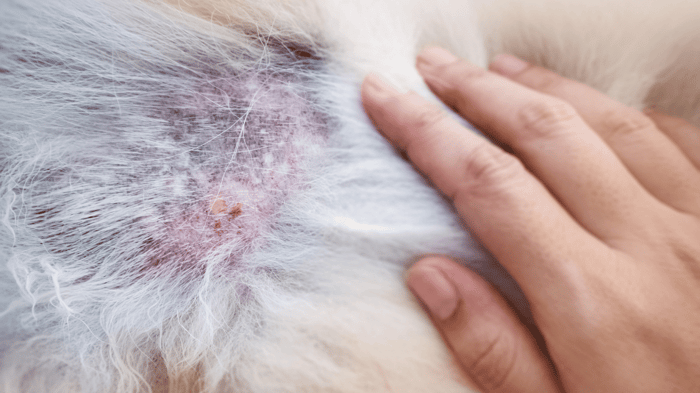
Atopic or allergic dermatitis is a common reason dogs may get sores on their skin and lose fur. 90% of allergens are in the environment, including dust mites, pollen, mold, or grass. It can also happen from parasites like fleas. Flea saliva can cause flea bite dermatitis.
It can also be food allergies, which a vet can test for. The most common food allergies are usually proteins like chicken, so don’t make an assumption about your dog’s allergies without testing and identifying what they are actually allergic to. (No dog food is hypoallergenic unless it specifically does not contain what your dog is actually allergic to).
Contact dermatitis can also be a problem. Sometimes this is due to environmental irritants, like chemicals in the garage, fertilizer on the lawn, or snow melt.
When dogs have atopic dermatitis, you will often also see:
- Itchy skin;
- Recurring ear infections;
- Chewing or licking paws; and
- Rubbing their face against the carpet.
Treatment
Allergies are difficult to treat since it depends on first establishing what the allergy actually is and then removing it from your dog’s environment and food (or limiting exposure). You can do this with blood tests. Also, remove any possible irritants that your dog may be in contact with, such as chemicals or fertilizers.
4. Parasites
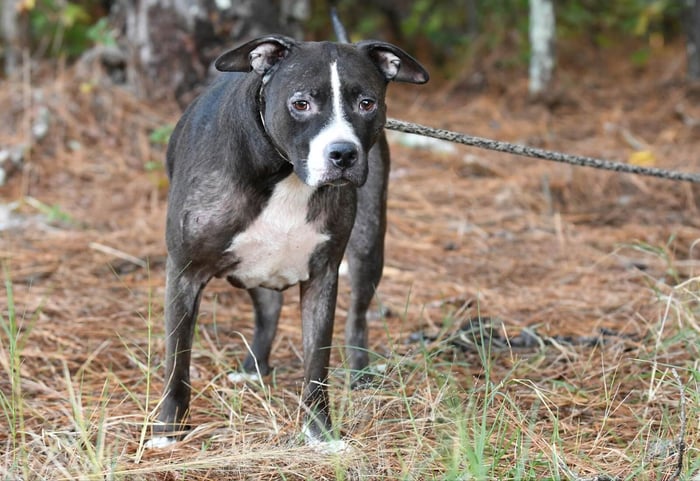
Parasitic infections such as demodectic and sarcoptic mange are perhaps the more famous reasons for dogs losing hair in huge patches all over their body and for causing scabs and skin lesions.
Flea infections can also be a problem, although it won’t be as dramatic as scabies and mange. Nevertheless, flea bite dermatitis can be problematic and extremely uncomfortable.
Treatment
Any form of mange can be tough to treat and will need special medicinal shampoos and a lot of dedication. Luckily, fleas only need regular flea treatments.
5. Self-Harm
Sometimes dogs scratch or chew so much on themselves that they lose chunks of hair and even break their own skin. Usually, this happens when they have really itchy skin. But sometimes, it can be from stress and frustration that dogs begin self-injurious behavior. It usually happens if dogs are confined to tiny places for too long.
If this is a severe behavior issue, the dog may need to be tested for problems like anxiety, canine-compulsive disorder, or other issues.
Treatment
The dog will need a combination of behavioral modification and possible medication to help to self-harm. If your dog is damaging their coat and skin because of itchiness, then it’s vital to deal with that issue first. Dogs should also get plenty of activity through out the day to avoid building frustration.
6. Immune Diseases and Hormonal Disorders
Of course, whenever a dog has constant skin issues causing sores and hair to fall out, then we need to look at underlying causes. A number of immune diseases affect a dog’s skin. Some to test for include:
Granuloma syndrome in dogs is quite rare, but its main symptom is definitely patchy hair loss, sores, and scabs. These sores are not itchy or painful, but they can become infected.
- Pemphigus
There are several different types of Pemphigus. But Pemphigus foliaceus specifically result in alopecia, open sores and scabs, mostly around the face and head.
- Lupus
Just like Pemphigus, there are different kind of lupus that affects dogs. Discoid lupus erythematosus (DLE), in particular, causes hair loss and crusty scabs that start from the nose.
- Cushing’s disease (hyperadrenocorticism)
This adrenal hormonal problem makes the skin thinner, causes sores, and causes the dog to lose hair along its sides (flanks), neck, and rear end.
- Cutaneous vasculitis
This is inflammation in the skin’s blood vessels and an autoimmune disorder. It is quite rare, but in its earliest forms, you may see patches of hair loss, followed by open sores and bleeding on a dog’s edges, such as on their ears.
Other hormonal issues such as diabetes and hypothyroidism often lead to dry skin, thinning, brittle fur, and some hair loss. Diabetes can also make the skin itchy, leading to scabs.
Treatment
Immune and hormonal disorders tend to be life-long problems. The first step is to get it correctly diagnosed. Your veterinarian may then prescribe hormonal treatment or immunosuppressive drugs to help your dog’s quality of life.
Final Thoughts
As you can tell from above, there is no simple answer to why you have patchy hair loss and scabbing or crusty skin. The most common reasons are mange, scabies, or skin infection. Allergies can also be the culprit, as well as nutritional deficiencies, stress disorders, or underlying hormonal and immune-system conditions.


